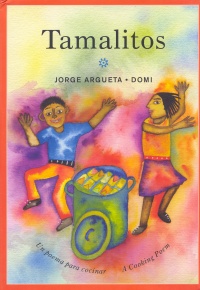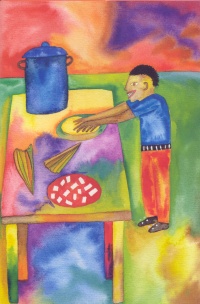| ________________
CM . . .
. Volume XIX Number 32. . . .April 19, 2013
excerpt:
Tamalitos is a poetic recipe written from a young boy’s perspective. It describes the step-by-step process he goes through when making tamalitos from corn masa and cheese, and the book offers readers insights into some of the folklore and history behind corn and the social importance of ritual and play in food preparation for the boy, his sister, and his family.
Like recipes in a recipe book, the tamalito-making process is described in chronological order. However, unlike many recipe books, the language that Arguata uses very skillfully awakens all the reader’s senses, adds great colour, and weaves in deep texture and shape to the imagined cooking activity. Such rich descriptive language allows the reader to clearly see and feel the tamalito-cooking experience. For example, just before the boy begins mixing the ingredients with his hands, he describes the corn flour as being “white, it’s yellow, it’s powdery, it’s soft”, and that “The kitchen is a field of corn in flower…I am dancing the dance of corn. The smell of corn makes me fly”. Additionally many of the steps are described using strong age-appropriate similes and metaphorical language that helps young readers visualize what to do and how. For example, the dough is cut into small packages “the size of your thumb”; it should be patted until is looks “like a little pillow” and shaped so that it has a narrow end “that’s like a tail”. Watercolor paintings are a vibrant, cheerful, riot of colours that fill the page and fully support the English text. The bold jewel tones are reminiscent of a Diego Rivera painting or a brightly woven multi colored Mexican shawl. The images are not cluttered and clearly illustrate the process and materials for making tamalitos. Most illustrations are of the young boy and his sister working in the kitchen of their home. There are no images of adults helping the children prepare the food, and, in some cases, the two children are shown doing work that some families would consider difficult or dangerous. For example, one picture shows the boy placing a pot of water on the stove to heat while the text instructs readers to “Light the fire under the pot.” Fortunately, asterisks are included at the end of sentences that describe difficult/dangerous activities requiring adult assistance and/or supervision. Unfortunately, the explanation for these asterisks is hard to find, and, after some searching, I located them in the text on the copyright page. Some readers would argue that such important safety information should have been provided a page of its own or placed as a footnote on the page(s) where safety issues are apparent. Tamalitos is a colourful well thought-out poetic recipe that teachers could easily use as a resource for a language or math class on sequencing, a quick introduction in Social Studies to the links between food and culture, or as resource for a health and wellness lesson (e.g., students could make their own tamalitos). Additionally, it could just as easily be used on the kitchen counter at home where a parent guides children in the tamalito-making process (my son and I will be doing so this weekend). The illustrations are vibrant and captivating, and the presence of English and Spanish on the page makes this a strong resource for ESL or SSL students. Recommended. Keith McPherson has been an elementary teacher and teacher-librarian in BC since 1984 and is currently a Program Advisor for the Teacher Education Office at the University of British Columbia in Vancouver, BC.
To comment
on this title or this review, send mail to cm@umanitoba.ca.
Copyright © the Manitoba Library Association. Reproduction for personal
use is permitted only if this copyright notice is maintained. Any
other reproduction is prohibited without permission.
NEXT REVIEW |
TABLE OF CONTENTS FOR THIS ISSUE
- April 19, 2013.
AUTHORS |
TITLES |
MEDIA REVIEWS |
PROFILES |
BACK ISSUES |
SEARCH |
CMARCHIVE |
HOME |

 The text is written in both Spanish and English and explains the process of making tamalitos in clear terms. Having both languages on the same page makes this a strong language learning resource for Spanish-speaking children learning English, or vice versa. The English text does not rhyme, but sentences are short, vocabulary is simple and lyrical, and sentences have a natural oral rhythm and structure making the poem an excellent read-aloud. The written English could be read independently by most seven- and eight-year olds.
The text is written in both Spanish and English and explains the process of making tamalitos in clear terms. Having both languages on the same page makes this a strong language learning resource for Spanish-speaking children learning English, or vice versa. The English text does not rhyme, but sentences are short, vocabulary is simple and lyrical, and sentences have a natural oral rhythm and structure making the poem an excellent read-aloud. The written English could be read independently by most seven- and eight-year olds.